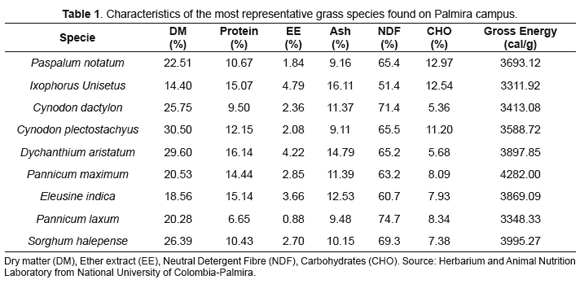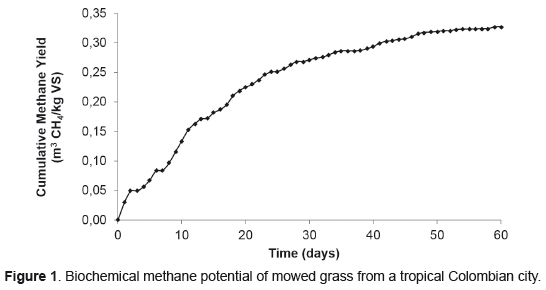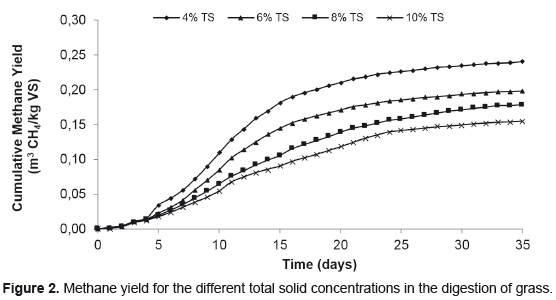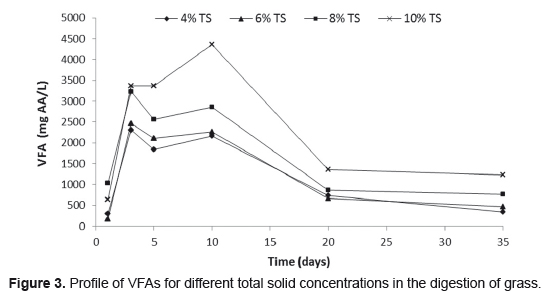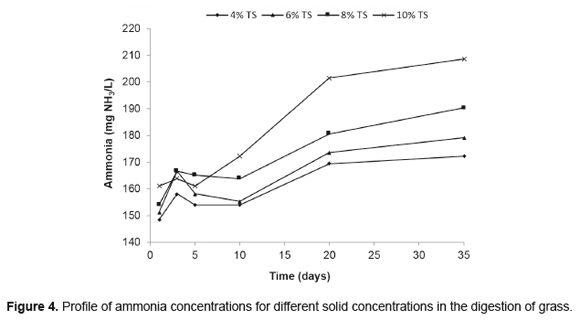Serviços Personalizados
Journal
Artigo
Indicadores
-
 Citado por SciELO
Citado por SciELO -
 Acessos
Acessos
Links relacionados
-
 Citado por Google
Citado por Google -
 Similares em
SciELO
Similares em
SciELO -
 Similares em Google
Similares em Google
Compartilhar
Revista ION
versão impressa ISSN 0120-100X
Rev. ion vol.29 no.1 Bucaramanga jan./jun. 2016
https://doi.org/10.18273/revion.v29n1-2016009
DOI: http://dx.doi.org/10.18273/revion.v29n1-2016009
of renewable energy in tropical countries
Luz Stella Cadavid-Rodríguez1*; Ingrid Vanessa Bolaños-Valencia2
1 Departamento de Ingeniería, Universidad Nacional de Colombia, Carrera 32 No 12-00 Palmira, Colombia.
*lscadavidr@unal.edu.co.
2 Joven Investigador, COLCIENCIAS. Carrera 31 C No 64-121 Palmira, Colombia.
Fecha Recepción: 9 de diciembre de 2015
Fecha Aceptación: 8 de enero de 2016
Grass from public green spaces of the tropical city of Palmira (Colombia) was analyzed to determine its potential to produce renewable energy trough anaerobic digestion. After pruning labor, grass samples were taken fresh in a representative way to form a big final sample. This sample was characterized and the grass species contained therein were identified. In a first experiment, a standard biochemical methane potential test was carried out at 37°C during 60 days. In a subsequent batch experiment, methane yield was optimized in terms of total solid concentration. Nine representative grass species were identified along with their nutritional content. It was found that the ultimate methane yield of the grass examined is 0.327m3CH4/kgVSadded, which is comparable with that reported for grass silage. A volatile solids removal of 44% was observed, and a removal of 45% cellulose, 12% hemicellulose, 4% lignin was found at the end of the experiment. Maximum methane yield was obtained at 4% of total solids, which may be recommended in a conventional anaerobic digestion process. Although more research is needed, this research showed that an economical and simpler operation can be suggested for the digestion of fresh grass in a tropical country like Colombia.
Keywords: anaerobic digestion, biochemical methane potential, mowed grass, renewable energy, tropical country.
de energía renovable en países tropicales
Se avaluó pasto de las áreas verdes públicas de la ciudad de Palmira (Colombia) para determinar su potencial para producir energía renovable a través de la digestión anaerobia. Después de realizados los trabajos de poda, se tomaron pequeñas muestras de pasto fresco para formar una muestra final representativa. La muestra se caracterizó y se identificaron las especies de gramíneas contenidas. En un primer experimento, se realizó una prueba del potencial bioquímico de metano a 37°C, durante 60 días. En una siguiente prueba por lotes, se optimizó la producción de metano en términos de la concentración de los sólidos totales. Se identificaron nueve especies de gramíneas representativas en la muestra y se estableció su contenido nutricional. La producción de metano final del pasto fue de 0,327m3CH4/kgSVadicionado, resultado comparable con lo encontrado en la literatura para pasto ensilado. La remoción de sólidos volátiles observada fue de 44%, y se registró una remoción del 45% de celulosa, 12% de hemicelulosa y 4% para la lignina. El mayor rendimiento de producción de metano se produjo con el 4% de sólidos totales. Este valor se puede recomendar en un proceso de digestión anaerobia convencional; sin embargo, se requiere continuar la investigación con el fin de determinar las condiciones de operación a escala real. La digestión anaerobia de pasto junto con otros residuos orgánicos urbanos podría convertirse en una opción sostenible para el manejo ambientalmente seguro de residuos orgánicos y para la producción de energía renovable en un país tropical como Colombia.
Palabras clave: digestión anaerobia, potencial bioquímico de metano, poda de pasto, energía renovable, país tropical.
de energia renovável em países tropicais
Grama de áreas verdes da cidade tropical de Palmira (Colômbia) foi analisada para determinar seu potencial para produzir energia renovável através da digestão anaeróbia. Após os trabalhos de poda, foi recolhido material fresco em vários pontos da cidade formando uma amostra final. A amostra foi caracterizada, identificando-se nove espécies de gramíneas representativas cujo conteúdo nutricional foi determinado. Numa primeira experiência, foi realizado um teste de potencial bioquímico de metano a 37°C durante 60 dias. Logo, num teste por lotes, otimizou-se a produção de metano por meio da variação da concentração de sólidos totais. A produção final de metano da grama foi de 0,327m3CH4/kgSVadicionado, o que é comparável com o relatado na literatura para silagem de erva. Uma remoção dos sólidos voláteis de 44% foi observada, em conjunto com uma remoção de 45% de celulose, 12% de hemicelulose e 4% de lignina. O rendimento máximo de metano obteve-se a partir de uma concentração de 4% de sólidos totais, sendo um valor que pode ser recomendado num processo de digestão anaeróbia convencional, embora sejam necessários mais testes. Ao final a digestão anaeróbia apresenta-se como uma operação econômica e simples para o tratamento de resíduos de poda em um país tropical como a Colômbia.
Palabras-chave: digestão anaeróbia, potencial de metano bioquímica, grama cortada, energia renovável, país tropical.
Cita: Cadavid-Rodríguez LS, Bolaños-Valencia IV. Grass from public green spaces an alternative source of renewable energy in tropical countries. rev.ion. 2016;29(1):109-16.
Although the potential of green urban areas to improve both the quality of life of city dwellers and urban sustainability is widely recognized, sometimes the maintenance needs of these areas in tropical developing countries may become a burden that threaten their sustainability. The rapid growth of grass in tropical cities, with average temperatures above 16°C all year long, makes of cutting the grass a permanent task which at the same time produces a green waste that must be disposed of. Part of the mowed grass is used as animal food but another important amount is disposed of to landfill, where, due to its organic nature, can produce leacheates and green house gases. However, greenery from public places could become a source of renewable energy in the form of methane, if anaerobic digestion (AD) is used as a management and disposal alternative for the green waste. In this way, the environmental and economical benefits of applying AD to the mowed grass, could ease the burden of maintenance and contribute to the sustainability of green areas in developing countries.
In Europe, grass is used in more than 50% of the digesters operating in Germany and Austria [1]. The digestion of grass silage has been widely reported in the literature, almost exclusively in the Nordic countries [2], therefore, in such climate conditions, the silage process is necessary [3,4,5].
Particularly, Colombia as tropical country with different climatic zones and rich biodiversity has a wide variety of species of grasses throughout its territory, which may become a source of renewable energy for the country. In fact, according to the Atlas of the energy potential of waste biomass in Colombia [6], greenery from public places of 12 Colombian municipalities has an energy potential of 318.13TJ/year. Therefore, it is worth exploring the ability of AD to harness the energy potential of mowed grass from one of the typical tropical cities of Colombia, even more when AD of grass has not been investigated previously in Colombia. The aim of this study was to investigate the methane potential from fresh mowed grass and to optimize biogas and methane production in terms of total solids concentration in a conventional anaerobic digestion process.
Substrate and inoculum
Mowed grass was obtained from the city of Palmira (average temperature of 24°C) on the main campus of the Universidad Nacional de Colombia. Five sampling points were established in the green areas using quadrants of 1m2. The sampling points were distributed following the order in which the work of pruning is done. Grass waste underwent field dried for a day (as usual before the collection), later a representative sample was taken and shredded until a fiber length of 2mm. After size reduction, the substrate was characterized and refrigerated at 4°C until use.
The inoculum used was a mesophilic anaerobic sludge collected from a UASB reactor treating domestic wastewater from the municipality of Ginebra (Valle del Cauca, Colombia). Before experiments, the sludge was centrifuged at 3000rpm for 10min and the TS content was adjusted. The inoculum was acclimatized at mesophilic conditions (37°C) during 30 days. This is because the experiment was carried out at this temperature, since mesophilic AD is considered more stable and better established than other AD conditions [7].
Experimental procedure
The biochemical methane potential test (BMP) was selected to evaluate the rate of degradation and the yield of biogas from the digestion of grass waste. The test was performed according to the method described by Owen et al. [8], with nutrient media modifications as described by Kim et al. [9]. Duran glass bottles of 500ml of capacity with hermetically sealed stoppers and controlled opening valves were used as reactors. The effective volume was 400 ml and the headspace gas volume was 100 ml. Substrate concentration of 2gVS/L was used and an Inoculum/Substrate ratio of 2 (based on volatile solids (VS)) was adopted for the test. Shredded grass, inoculum and mineral media were mixed and loaded to the bottles which were incubated at 37°C for 60 days. The number of replicates was three and also a control assay (without substrate) was carried out in triplicate to correct for the methane production of the inoculum.
In a second experiment, the methane yield was optimized as a function of the total solids (TS) fed to a batch reactor. The concentrations of TS evaluated were: 4, 6, 8 and 10%, for a total of 4 treatments. The same equipment was used and the same operational conditions (effective volume, temperature, and mixing) were adopted as in the BMP test. For this experiment, however, the Inoculum/Substrate ratio was 1 and the digestion process was followed for a period of 35 days. The reason for these changes is that it was intended to replicate real operation conditions.
The gas production was determined daily using the liquid displacement technique and representative samples were analyzed by gas chromatography for methane content.
Analytical methods
Regular samples were taken from each reactor on defined days and after centrifuging the samples at 4000rpm for 20min, analyses of pH, TS, VS, soluble chemical oxygen demand (soluble COD), ammonia, alkalinity, volatile fatty acids (VFA) and Total Kjeldahl Nitrogen (TKN) were conducted following the methods outlined in Standard Methods [10]
The composition of the biogas (CH4 and CO2) was measured on a SRI gas chromatograph (GC) equipped with a thermal conductivity detector and a 2.44m stainless steel column packed with Haysep (80/100 mesh).
Statistical analysis of variance (ANOVA factorial), using P<0.05 as statistical significance, was performed using IBM SPSS Statistics V20.
Grass identification and characterization
From information provided and analyses performed by the Herbarium and the Animal Nutrition Laboratory of the Universidad Nacional de Colombia (Palmira campus), it was possible to determine the most representative species of grasses and their characteristics (Table 1). Nine representative species were identified showing the biodiversity that characterizes the tropics. The majority of grass species have protein content above 10%, carbohydrates are between 5.7 and 13%. With respect to fiber content (cellulose, hemicellulose and lignin), it is in the range 51 to 75%.
Specifically, the total fiber content for the representative grass sample formed was 70% (Table 2). The fiber content is a key parameter to the anaerobic digestion process because it is known that, while cellulose is readily biodegradable, hemicellulose and lignin are difficult to degrade under anaerobic conditions. The high level of ash found (21.1%) may be due to entrainment of minerals from the soil such as silt, clay and sand content in the grass sample.
Biochemical methane potential (BMP) of grass
Biochemical methane potential of the grass evaluated was found to be 0,327±2m3CH4/kgVSadded (Figura 1). This methane yield is very close to the range reported for grass silage of 0.350- 0.490m3CH4/kgVSadded [11]. However, it is important to consider that grass silage is more biodegradable than fresh grass [12] and higher methane yield has been obtained from grass silage compared to that of fresh grass [13]. Therefore, the methane potential obtained in the present study for fresh grass is high compared to that obtained from grass silage. The competitive methane production found in this research may be attributed to huge biodiversity found in the grass sample, specifically the mixture of species of grasses [14] and other herbs that are found in the green areas of Palmira (Table 1).
The proportion of CH4 in biogas was around 35-40% initially and rose to 75-82% within 10 days. It has been found that the methane yield is related to the state of maturation of the plants due to variations in the amount of lignin in the cell wall and the content of soluble carbohydrates [15]. However, in the grass sample examined it was observed vegetal material in different stages of maturation and thus it was not possible to establish a direct relation between stages of maturity and the generation of methane. Nevertheless, when the grass was analyzed it was found that the percentage of lignin was relatively low, about 10%.
After digestion, it was observed an average cellulose, hemicellulose and lignin removal of 45%, 12% and 4%, respectively. This is a predictable result, since as reported by literature, a major problem of biodegradation of lignocellulosic residues is the low accessibility of the fermentable sugars contained in the biomass and in particular, the degradation of lignin [16]. Volatile solids removal was 44% which can be attributed mainly to protein, carbohydrates and cellulose conversion.
Batch experiments of methane fermentation under different grass concentrations
The profile of cumulative methane yield as a function of time (Figura 2) showed differences between total solid concentrations, a rapid methane production period was clearly reached between days 5 and 15 at the lower solid concentrations (4 and 6%TS), while the exponential phase was not so evident at the higher concentrations examined (8 and 10%TS). Authors explained this behavior arguing that an increment of initial organic matter prolongs the hydrolytic and acidogenic stages [17].
It was found a significant difference in the methane yield between a solid concentration of 4% and the higher concentrations. On the other hand, there was no a significant difference between the experiments with solid concentration of 6% and 8% of TS. Clearly, the experiment with 10% of TS was the one that showed the lower methane yield, with a statistical difference.
The higher methane yield was achieved at solid concentration of 4% TS with 0.241m3CH4/kgVSadded; while higher TS concentrations showed lower methane yields. This has been previously reported in the literature [18], the authors concluded that by increasing the organic loading on the anaerobic digestion process, a microbial inhibition is caused, which limits the conversion efficiency of the organic matter.
During the digestion process, pH was between 6.3 and 7.1. Lower pH values were obtained on day 10, coinciding with maximum COD soluble and the higher VFAs production period (Figura 3). As the solids increased there was a higher VFA production. However, although high VFA concentrations were observed (2500 - 4500mgAA/L), the VFA/alkalinity ratio remained below 1 and pH did not decrease to a critical level; which makes evident that the system showed good buffering capacity.
Ammonia contributed to maintain the alkalinity in the system. In general, the ammonia concentration showed a clear trend of increase with time, reaching the highest values in the reactors with the concentration of 8 and 10% of ST (Figure 4).
On the other hand, the total Kjeldahl nitrogen (TKN) removal ranged between 41 and 47% for all concentrations tested (Table 3). This could be attributed to enhanced hydrolysis of proteins. The higher TS concentrations exhibited the lower removals.
The results of this research indicate that anaerobic digestion of mowed grass from green areas in Colombia might be an alternative source of renewable energy in the form of biomethane. An ultimate methane potential of 0.327m3/kgVSadded was obtained from this substrate which could be of commercial interest. Given that the grass species in this study were not pretreated, and the collected grass was just shredded and not ensiled before feeding to the digester, an economical and simpler operation can be suggested for the digestion of the fresh grass evaluated.
The digestion allowed an important fiber and VS removal. Cellulose, hemicellulose and lignin were reduced by 45%, 12% and 4% respectively. With regard VS, there was a 44% of removal.
For a conventional digestion process, it was found that the optimum total solid concentration to generate methane from mowed grass was 4%. Higher values limited the generation of methane due to the increase of organic loading with the consequent drop in pH.
More research is needed to optimize the operating conditions of conventional AD of mowed grass, but also to explore alternative digestion processes in order to propose a cost-effective process for a tropical developing country like Colombia.
The authors wish to thanks Universidad Nacional de Colombia, specially to DIPAL for providing the financial support through the project QUIPU 20201001103. We also wish to thank to the staff of Animal Nutrition, Environmental Analyses and Environmental Researches laboratories for their kind collaboration in the experimental work.
[1] Prochnow A, Heiermann M, Plöchl M, Linke B, Idler C, Amon T, Hobbs PJ. Bioenergy from permanent grassland - A review: 1. Biogas. Bioresour. Technol. 2009;100:4931-44. [ Links ]
[2] Wall D, Padraig O'Kiely, Murphy Jerry D. The potential for biomethane from grass and slurry to satisfy renewable energy targets. Bioresource Technology. 2013;149:425-31. [ Links ]
[3] Lehtomäki A, Viinikainen TA, Rintala JA. Screening boreal energy crops and crop residues for methane biofuel production. Biomass Bioenergy. 2008;32:541-50. [ Links ]
[4] Prochnow A, Heiermann M, Drenckhan A, Schelle H. Seasonal pattern of biomethanisation of grass from landscape management. CIGR E-Journal. 2005;7:1-15. [ Links ]
[5] Seppälä M, Paavola T, Lehtomäki A, Rintala J. Biogas production from boreal herbaceous grasses - Specific methane yield and methane yield per hectare. Bioresour. Technol. 2009;100:2952-8. [ Links ]
[6] Colombian Ministry of Mines and Energy. 2009 Atlas of the energy potential of waste biomass in Colombia. http://www1.upme.gov.co/sites/default/files/article/1768/files/Atlas%20de%20Biomasa%20Residual%20Colombia.pdf. (Acceso 1 October 2014). [ Links ]
[7] Yang L, Xu F, Ge X, Li Y. Challenges and strategies for solid-state anaerobic digestion of lignocellulosic biomass. Renewable and Sustainable Energy Reviews. 2015;44:824-34. [ Links ]
[8] Owen WF, Stuckey DC, Healy JB. Bioassay for monitoring biochemical methane potential and anaerobic toxicity. Water Research. 1979;13(6):485-92. [ Links ]
[9] Kim HW, Han SK, Shin HS. The optimisation of food waste addition as a co-substrate in anaerobic digestion of sewage sludge. Waste Management and Research. 2003;21(6):515- 26. [ Links ]
[10] APHA 2005. Standard Methods for the Examination of Water and Wastewater. American Public Health Association. Water Pollution Control Federation. Washington, Estados Unidos; 2005. [ Links ]
[11] Nizami A, Korres N, Murphy J. Review of the integrated process for the production of grass biomethane. Environ. Sci. Technol. 2009;43:8496-508. [ Links ]
[12] Hidaka T, Arai S, Okamoto S, Uchida T. Anaerobic co-digestion of sewage sludge with shredded grass from public green spaces. Bioresour. Technol. 2013;130:667-72. [ Links ]
[13] Holliday L. Rye-grass as an energy crop using biogas technology. UK Department of Trade and Industry (DTI). Report No. B/ CR/00801/00/0. United Kingdom; 2005. [ Links ]
[14] Nizami A, Orozco A, Groom E, Dieterich B, Murphy J. How much gas can we get from grass?. Applied Energy. 2012;92:783-90. [ Links ]
[15] Barakat A, Gaillard C, Steyer J, Carrere H. Anaerobic biodegradation of cellulose-xylan- lignin nanocomposites as model assemblies of lignocellulosic Biomass. Waste and Biomass Valorization. 2013;5(2):293-304. [ Links ]
[16] Fernandez J, Pérez M, Romero LI. Effect of substrate concentration on dry mesophilic anaerobic digestion of organic fraction of municipal solid waste (OFMSW). Bioresource Technology. 2008;99:6075-80. [ Links ]
[17] Liu G, Zhang R, El-Mashad Hamed M, Dong R. Effect of feed to inoculum ratios on biogas yields of food and green wastes. Bioresource Technology. 2009;100:5103-8. [ Links ]
[18] Cadavid LS, Horan NJ. Biomass potential of sewage screenings using mesophilic anaerobic digestion. Biogas Engineering and Application. 2011;1:44-53. [ Links ]













